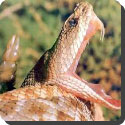 It depends what you mean by dangerous! Certainly, not all snakes are poisonous, and of those which are, only a very small number are dangerous to people. But in the same way that people could be said to be a danger to the things they eat, snakes are dangerous to their prey. Most snakes kill their prey- rats, mice and other small animals by what scientists call constriction, which means coiling round the prey and squeezing it to death. Usually the snake then swallows the prey whole; it has specially adapted jaws to enable it to swallow creatures much wider than itself.
It depends what you mean by dangerous! Certainly, not all snakes are poisonous, and of those which are, only a very small number are dangerous to people. But in the same way that people could be said to be a danger to the things they eat, snakes are dangerous to their prey. Most snakes kill their prey- rats, mice and other small animals by what scientists call constriction, which means coiling round the prey and squeezing it to death. Usually the snake then swallows the prey whole; it has specially adapted jaws to enable it to swallow creatures much wider than itself.
There are only three types of snake in Britain; the slow worm is not a snake at all but a legless lizard. The first of these is the grass snake, which is not poisonous and eats mice, frogs and newts. Its size may frighten people: it has been known to reach a length of some five and three quarter feet. The second British snake, the smooth snake, is non-poisonous. It grows only to a length of about thirty inches, and eats insects and lizards. The last snake to be found in Britain is the common viper or adder. This one is poisonous, but although its bite needs immediate attention, it is unlikely that its bite would kill you. The adder usually has a long zigzag band edged with a double row of dark spots on its back, whereas the grass and smooth snakes have indistinct markings or speckles. The grass snake also has a yellowish white collar just behind its head, so you can easily tell the difference.
 Kids Portal For Parents India Kids Network
Kids Portal For Parents India Kids Network






